Strawberry-Rhubarb Galette with Suet-Butter Pastry
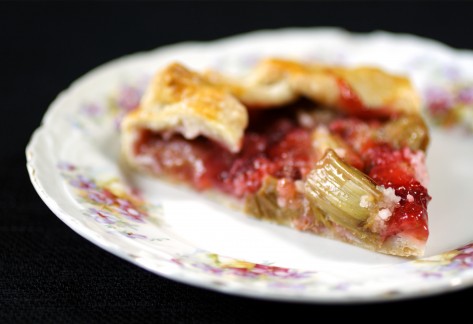
Filled with seasonal, locally grown strawberries and rhubarb, this galette recipe could be in the newest DCCC pick, Ripe, a gorgeous book devoted to 23 fruits and nuts. But it is not. I haven’t quite left Fat yet, the last DCCC pick. (The club seems to be on a trend of sensual, single word titles.)
After following author Jennifer McLagan’s method for preparing suet for use in pastry, found in Fat, I used it to make a pie. I fell in love with the crispy, flaky texture of the dough, and found it much easier to work with than an all-butter pie dough.
The first step is preparing the suet, the fat that surrounds an animal’s kidneys—usually cow or sheep. It is a task, but given the results, I think it’s worth it. I hope you think so too. If not, you’ll have wasted just one afternoon of your life and learned something about animal anatomy.
Prepare Suet for Pastry Making
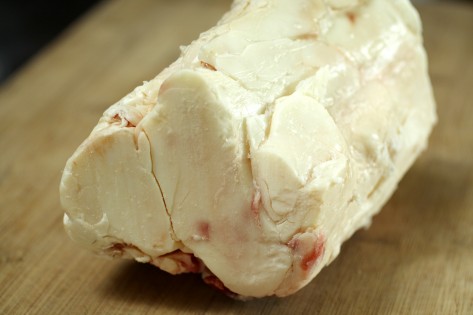
Suet
This is a two-day process so plan ahead. You will need a food processor with a grating disk. Because of the work involved in preparing suet, it’s best to make a large batch. It may be frozen, and used directly from the freezer when making pastry. Clean-up requires very hot water and lots of soap. (That’s how you know you’re dealing with a saturated fat.)
1. Cut off any traces of kidney or blood or any discolored pieces of fat.
2. Cut the suet into chunks. As you break down the suet you will notice that there are natural breaks in the fat. Pull these sections apart. You will notice a thin, papery membrane that is clear, like cellophane, holding the sections of fat together. Pull off the membrane.
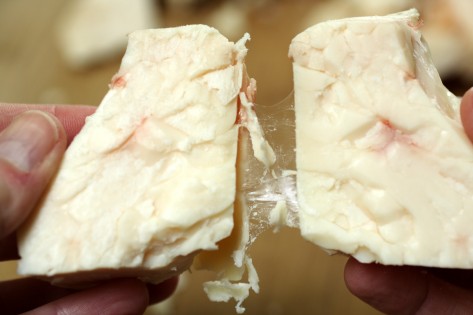
Thin membrane that holds fat together
3. Continue to break down the suet, cutting it into chunks that will fit into the tube of a food processor. Continue to pull of the membrane as you cut the suet. Removing the membrane, which tends to stick to your fingers, is the part of the job that requires the most patience.
4. Place the suet chunks in a bowl and set in the freezer until the next day. Place the grating disk of a food processor in the freezer as well.
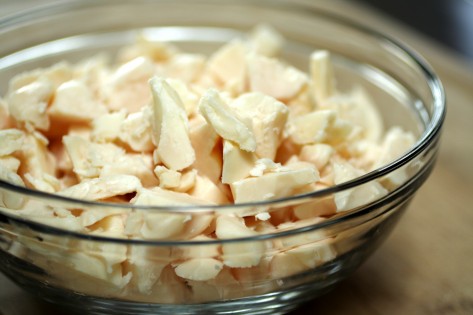
Suet ready to be grated
5. When you’re ready to grate the suet, dust the chilled grating disk with flour. Feeding the suet chunks through the tube on your food processor lid, grate the suet. Re-dust the grating disk with flour between gratings to keep it from getting gunked up with fat.

Chilled grating disk dusted with flour
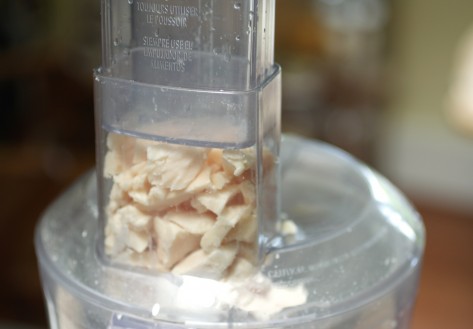
- Suet in food processor tube
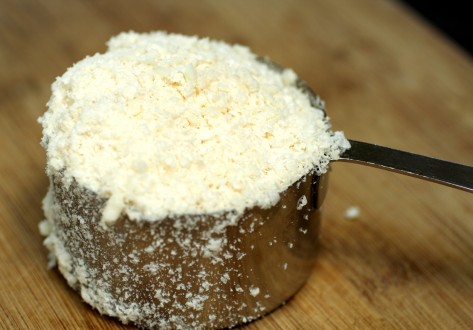
Grated suet
(Suet preperation adapted from method in Fat by Jennifer McLagan)
The Galette
Now that you’ve prepared the suet for pastry making, the rest is easy. The following recipe is a 3-way: the dough, which uses a food processor, is adapted from Jennifer McLagan’s recipe for Suet and Butter Pastry in Fat; the filling is adapted from a recipe in Joy of Cooking (1997 edition); and the galette forming instructions and bake time and temp are from Martha Stewart’s Cooking School.
Make the suet-butter dough:
1 cup (5 ounces) all-purpose flour
¼ teaspoon salt
3 tablespoons (1½ ounces) semi-frozen, unsalted butter, diced
½ cup (1½ ounces) grated suet
¼ cup ice-cold water, plus a little more if needed
- Place the blade of a food processor in the freezer.
- Place the flour and salt in the bowl of a food processor fitted with the chilled blade. Pulse to combine. Add the butter and pulse until the majority of the mixture resembles very coarse bread crumbs, with some of the butter pieces remaining as large as small peas. Do not over mix. Add the suet and pulse a couple times to combine.
- Transfer the flour and fat mixture to bowl. Add the ¼ cup water and stir to combine with a fork. Pinch some of the mixture between your fingers. If it does not hold together, stir in 1 or 2 more teaspoons of water and test again.
- Place the dough on a lightly floured surface and gently knead into a ball. Flatten to a disk and wrap tightly with plastic wrap. Refrigerate for at least 1 hour before using, or make the day ahead.
Make the filling:
¾ to 1 pound rhubarb, trimmed (large stalks cut lengthwise into 1/2-inch strips)
2 cups strawberries, hulled and cut in half lengthwise (keep small berries whole)
¾ cup sugar
1½ tablespoons cornstarch
¼ teaspoon salt
Cut the rhubarb into 1-inch lengths. Measure 2½ cups rhubarb and place in a large bowl with the strawberries. Sprinkle on the sugar, cornstarch, and salt and stir to combine. Let stand 10 to 15 minutes, stirring occasionally.
Make the galette:
Chilled suet-butter dough (recipe above)
1 egg
1 tablespoon half-and-half or heavy cream
Sugar, for sprinkling rim
- Preheat the oven to 375°F. Line a large rimmed baking sheet with parchment paper.
- Remove the dough from the refrigerator and allow it to soften for about 10 minutes before rolling it.
- On a lightly floured surface, roll the dough out to a roughly 11-inch circle. It doesn’t have to be perfect—this is the joy of making a galette.
- Transfer the dough to the prepared baking sheet. Spoon the rhubarb-strawberry filling into the center of the dough, leaving 1½-inch border around the edge. Fold the dough up and over the filling, allowing it to fall into natural creases, pleating them as you go.
- Whisk together the egg and cream and brush lightly onto the pastry. Sprinkle the rim with a little sugar.
- Bake until the pastry is golden brown and the filling is bubbling, about 1 hour, 15 minutes. Use a spatula to release the galette from the sheet of parchment. Transfer the sheet of parchment and galette to a wire rack and let cool about 15 minutes. Then remove the galette from the sheet and serve warm or place on the wire rack to cool completely.

Hey Holly, I love using suet for savory knishes and pastys, but have never used it for sweet fillings. And I am puzzled by the measurements: You are using 1 cup of flour to a scant cup of fat? AND a third of a cup of water? I can’t imagine…
1Hi Sharon, Well, this is my first intro to using suet. I’ll have to try savory treatments next. This recipe does use a lot of fat, but it works. I did find a few recipes for pastry dough that did have about the same about of fat to flour as this recipe, though usually, it does seem that the ratio of fat to flour is less that what’s used here. Is that your experience with pie crusts and the like? I’m fairly new to pastry making and so am no expert. I used my scale for all of the measurements, and so didn’t double-check the cup equivalent. But the cup measurement should be in the neighborhood, if not exact. The resulting crust is very crispy crust–no doubt from all of that fat. One tip: if you use the crust to make a pie be sure to bake the pie on a sheet pan. A bit of the suet drips from the crust as it bakes. I suppose it’s being rendered as it bakes!
2Holly, for my regular pie crust I use 2 cups (9 oz) flour with 3 ounces each of butter and lard and 3 ounces of water. So maybe the suet measurement isn’t as outlandish as It first appeared since suet is certainly waxier and more malleable without melting than lard is. I’m going to try it!
3Excellent! Let me know how it goes, how you like working with it, and if you like the texture and flavor.
4